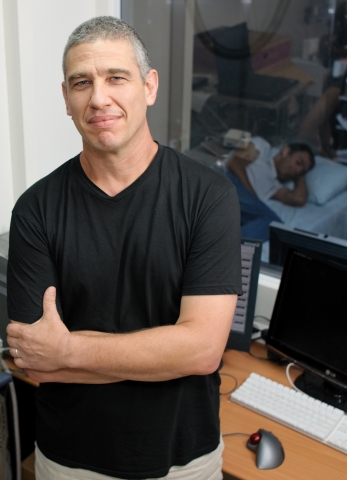Nice to sniff you
Handshakes may engage our sense of smell
Briefs

Funerary stele of Thrasea and Euandria. Marble, ca. 375-350. Wikimedia Commons - Marcus Cyron
Why do people shake hands? A new Weizmann Institute study suggests one of the reasons for this ancient custom may be to check out each other’s odors.
Even if we are not consciously aware of this, handshaking may provide people with a socially acceptable way of communicating via the sense of smell.
Not only do people often sniff their own hands, but they do so for a much longer time after shaking someone else’s hand, the study found. As reported in the journal eLife in March, the number of seconds the subjects spent sniffing their own right hand more than doubled after an experimenter greeted them with a handshake.
Handshakes vary in strength, duration and posture, so they convey social information of various sorts,” says Prof. Noam Sobel, head of Weizmann’s Department of Neurobiology. “But our findings suggest that at its evolutionary origins, handshaking might have also served to convey odor signals, and such signaling may still be a meaningful, albeit subliminal, component of this custom.”
“Our findings suggest that people are not just passively exposed to socially significant chemical signals, but actively seek them out,” said Idan Frumin, a research student who conducted the study under the guidance of Prof. Sobel. “Rodents, dogs and other mammals commonly sniff themselves, and they sniff one another in social interactions. It seems that in the course of evolution, humans have retained this practice—only on a subliminal level.”
To examine whether handshakes indeed transfer body odors, the researchers first had experimenters wearing gloves shake the subjects’ bare hands, then tested the glove for smell residues. They found that a handshake alone was sufficient for the transfer of several odors known to serve as meaningful chemical signals in mammals. “It’s well known that germs can be passed on through skin contact in handshakes, but we’ve shown that potential chemical messages, known as chemosignals, can be passed on in the same manner,” Frumin says.
The sense of smell also matters within genders (man to man and woman to woman) in addition to across genders, the study found.
https://www.youtube.com/watch?v=6r91sFUTezE
Prof. Noam Sobel is supported by the Norman and Helen Asher Center for Brain Imaging, the Nella and Leon Benoziyo Center for Neurosciences, and the Carl and Micaela Einhorn-Dominic Institute for Brain Research, all of which he heads. In addition he is supported by the Nadia Jaglom Laboratory for the Research in the Neurobiology of Olfaction, the Adelis Foundation, the James S. McDonnell Foundation 21st Century Science Scholar in Understanding Human Cognition Program, Mr. & Mrs. H. Thomas Beck of Canada, the Minerva Foundation, the European Research Council, Nathan and Dora Oks of France, Mike and Valeria Rosenbloom through the Mike Rosenbloom Foundation, and the estate of David Levidow.

Prof. Noam Sobel








